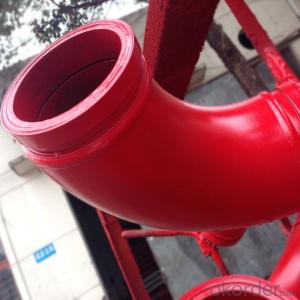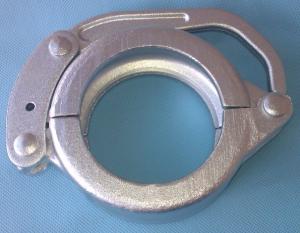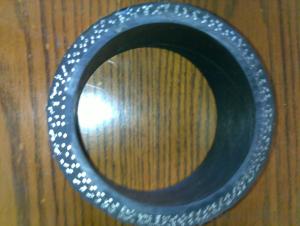CONCRETE DELIVERY ELBOW PM TYPE 90DEG R275 DN125
- Loading Port:
- Tianjin
- Payment Terms:
- TT OR LC
- Min Order Qty:
- 100 pc
- Supply Capability:
- 10000 pc/month
OKorder Service Pledge
OKorder Financial Service
You Might Also Like
concrete pump elbow table
Wear-resistant Single or Double Concrete Pump Elbow | |||||||
Type | Singe Elbow | Double Elbow | |||||
Model | DN125 | DN150 | DN175 | DN125 | |||
Material | Casting Steel ,ST52 | Inside | 40Cr | Outside | |||
Size | R275*90° | R275*90°+110 | 36° | F2000 | R275*90° | R275*90°+110 | |
R275*45° | R275*90°+211 | R400*30° | A3000 | R275*45° | R275*90°+211 | ||
R275*25° | R275*90°+411 | R400*45° | 471B | R275*25° | R275*90°+411 | ||
R275*20° | R275*90°+424 | R400*30° | 571B | R275*20° | R275*90°+424 | ||
R275*15° | R275*45°+170 | R488*90° | A1000 | R275*15° | R275*45°+170 | ||
R180*90° | R275*45°+310 | R500*90 | C1000 | R180*90° | R275*45°+310 | ||
R232*60° | R275*45°+310 | R280*90° | B2000 | R232*60° | R275*45°+310 | ||
R240*36° | 20°Lengthen | R240*36° | 20°Lengthen | ||||
R240*30° | 25°+740 | R240*30° | 25°+740 | ||||
R240*15° | 40°Zoomlion | R240*15° | 40°Zoomlion | ||||
R385*29° | R385*29° | ||||||
R315*33° | R315*33° | ||||||
Technic | Forged | ||||||
Average life | 25,000cubic | 50,000cubic | |||||
Appliciation | Used in concrete transport in construction work | ||||||
1.product profile:The double layer concrete pump elbow is developed by ourselves through new
technology and process.
2.characteristic:the inner layer of this concrete pump elbow undergoes heat treatment,and then the rigitiry can reach 62-65HRC.
3.characteristic:the outer layer of the concrete pump elbow possess good toughness properties
to protect the inner layer,so the security of the elbow is improved.
4.life:the experiment done abroad shows that the life of our concrete pump elbow can reach 35000-50000cbm,got the customers' praise
5.Beside the double layer concrete pump elbow,we produce all kinds of concrete pump parts,
straight pipe hose flange coupling and so on.




- Q: Can concrete pump spare parts be coated with anti-corrosion or anti-wear coatings?
- Certainly, it is possible to apply anti-corrosion or anti-wear coatings to concrete pump spare parts. These coatings serve as an extra protective layer, effectively shielding the spare parts from corrosion and wear caused by the tough operating conditions and abrasive substances encountered during concrete pumping. Usually composed of materials like epoxy, polyurethane, or ceramic, these coatings boast exceptional resistance against corrosion and wear. By applying these coatings, the lifespan of concrete pump spare parts can be significantly prolonged, consequently reducing the need for frequent replacements and resulting in cost savings for operators. Furthermore, the presence of anti-corrosion and anti-wear coatings can enhance the overall performance and efficiency of the concrete pump, ensuring smooth and dependable operation.
- Q: What are the layout requirements of concrete pump for building engineering?
- The concrete pump shall be as close as possible to the casting site. In the use of cloth rod work, should make the casting parts as far as possible within the working range of the distribution rod, as little as possible to move the pump, that is able to complete the pouring.
- Q: What is the function of a concrete pump hopper grate pin?
- The function of a concrete pump hopper grate pin is to securely hold the grate in place, preventing it from shifting or becoming dislodged during the concrete pumping process.
- Q: What are the signs of a malfunctioning lubrication system?
- Some signs of a malfunctioning lubrication system include increased friction and heat, unusual noises coming from the engine or components, excessive wear and tear on moving parts, and a decrease in overall performance and efficiency of the machinery or vehicle.
- Q: What are the different sizes of concrete pump pipes available?
- The sizes of concrete pump pipes typically range from 2 inches to 6 inches in diameter.
- Q: What are the indications of a worn-out concrete pump clamp?
- A worn-out concrete pump clamp may exhibit several indications that replacement is necessary. These indications commonly include: 1. Leakage: In the event of leakage around the clamp area while operating the concrete pump, it could signify a worn-out clamp. This leakage may be a result of a faulty seal or gasket, which can no longer establish a secure and tight connection between the pump and the hose. 2. Vibrations and rattling: Excessive vibrations and rattling during the pumping process can be attributed to a worn-out clamp. This can occur when the clamp fails to firmly hold the hose in place, resulting in movement and instability. 3. Difficulty in tightening: If you encounter increasing difficulty in properly tightening the clamp, it may indicate wear-out. Over time, the components of the clamp may deteriorate, making it more challenging to achieve a secure and tight connection. 4. Visual damage: Inspect the clamp for visible signs of damage, such as cracks, dents, or corrosion. These physical damages can compromise the clamp's functionality, potentially leading to leaks or instability. 5. Excessive wear and tear: If you have been utilizing the same concrete pump clamp for an extended period without replacement, it is advisable to regularly inspect it for signs of excessive wear and tear. This may include worn-out or missing bolts, a deformed clamp body, or any other visible signs of deterioration. Promptly addressing any indications of a worn-out concrete pump clamp is crucial to ensure the safety and efficiency of pumping operations. If any of these signs are observed, it is recommended to seek professional consultation or replace the clamp to prevent potential accidents or disruptions in the concrete pumping process.
- Q: What is the purpose of a concrete pump hopper grate?
- The purpose of a concrete pump hopper grate is to prevent large debris or foreign objects from entering the pump and potentially causing damage or blockages. The grate acts as a filter, allowing only smaller particles and liquid concrete to pass through while blocking larger materials such as rocks, wood, or other debris. This helps to maintain the efficiency and functionality of the pump, ensuring a smooth and uninterrupted flow of concrete. Additionally, the grate also helps to protect the pump's internal components, such as the impeller and valves, from potential damage caused by large objects. Overall, the concrete pump hopper grate plays a crucial role in maintaining the quality and reliability of the pumping process, preventing potential issues and ensuring a successful concrete placement.
- Q: What is the function of a concrete pump hopper grate handle?
- The main purpose of a handle on a concrete pump hopper grate is to manually control the opening and closing of the grate. The grate is an essential part of the pump as it allows concrete to enter the pumping system. By using the handle, the operator can adjust the position of the grate in order to control the flow of concrete and prevent any large debris or foreign objects from entering the system. This is crucial for ensuring the smooth operation of the pump and maintaining the quality of the pumped concrete. Additionally, the handle provides easy access to the grate for maintenance and cleaning purposes. Overall, the handle on the concrete pump hopper grate plays a crucial role in regulating the flow of concrete and ensuring the efficiency and reliability of the pumping process.
- Q: How can one source reliable suppliers for concrete pump spare parts?
- One can source reliable suppliers for concrete pump spare parts by following a few steps. Firstly, it is important to conduct thorough research on potential suppliers. This can be done by searching online directories, industry forums, and marketplaces dedicated to construction equipment and spare parts. Reading customer reviews and ratings can provide valuable insights into the reliability and quality of the suppliers. Secondly, it is advisable to reach out to industry professionals and experts who have experience in the concrete pump industry. They can provide recommendations and references for reliable suppliers they have worked with in the past. Additionally, attending trade shows and exhibitions related to the construction industry can be a great way to connect with suppliers and evaluate their product offerings in person. This allows for direct communication and the opportunity to assess the reliability and quality of their spare parts. Moreover, it is essential to request samples or product catalogs from potential suppliers to ensure that the spare parts meet the required specifications and quality standards. This can help in assessing the reliability of the suppliers and the compatibility of their products with the concrete pump. Furthermore, conducting background checks on the suppliers is crucial. Verifying their credentials, certifications, and licenses can provide assurance of their reliability and professionalism. It is also beneficial to inquire about their manufacturing processes and quality control measures to ensure the consistency and durability of the spare parts. Lastly, comparing prices, warranties, and after-sales services offered by different suppliers can help in making an informed decision. It is important to strike a balance between the cost and the reliability of the suppliers to ensure a long-term and fruitful partnership. By following these steps and taking the time to thoroughly evaluate and research potential suppliers, one can source reliable suppliers for concrete pump spare parts and ensure the smooth operation and maintenance of their equipment.
- Q: What are the advantages of using ceramic components in concrete pump spare parts?
- Using ceramic components in concrete pump spare parts offers several advantages. Firstly, ceramic materials are renowned for their exceptional durability and resistance to wear. Given the high pressure and intense forces that concrete pumps operate under, it is crucial to have components that can withstand such conditions. Ceramic parts possess superior hardness and strength, making them highly resistant to wear and extending the lifespan of spare parts. Secondly, ceramic components boast excellent corrosion resistance. Concrete consists of various chemicals and substances that can corrode metals. By utilizing ceramic parts, the risk of corrosion is significantly reduced, ensuring the longevity and reliability of the concrete pump spare parts. Furthermore, ceramic materials exhibit low friction coefficients. Consequently, when ceramic components are incorporated into concrete pumps, there is less friction between moving parts. This results in reduced energy consumption and increased efficiency. Ultimately, this can lead to cost savings and improved overall performance of the concrete pump. Moreover, ceramic parts possess high thermal resistance. Concrete pumps generate substantial heat during operation, which can potentially damage or deform certain components. However, ceramic materials can withstand high temperatures without compromising their structural integrity. This ensures the reliability and safety of the concrete pump. Lastly, ceramic components demonstrate excellent dimensional stability. They are less susceptible to expansion or contraction caused by temperature changes. This feature guarantees that spare parts maintain their shape and fit precisely within the concrete pump. Consequently, this precision fitting helps minimize leakage and maintain the pump's efficiency. In summary, the utilization of ceramic components in concrete pump spare parts offers exceptional durability, corrosion resistance, low friction, high thermal resistance, and dimensional stability. These advantages contribute to an increased lifespan, improved performance, reduced maintenance costs, and enhanced overall efficiency of the concrete pump.
Send your message to us
CONCRETE DELIVERY ELBOW PM TYPE 90DEG R275 DN125
- Loading Port:
- Tianjin
- Payment Terms:
- TT OR LC
- Min Order Qty:
- 100 pc
- Supply Capability:
- 10000 pc/month
OKorder Service Pledge
OKorder Financial Service
Similar products
Hot products
Hot Searches
Related keywords

























